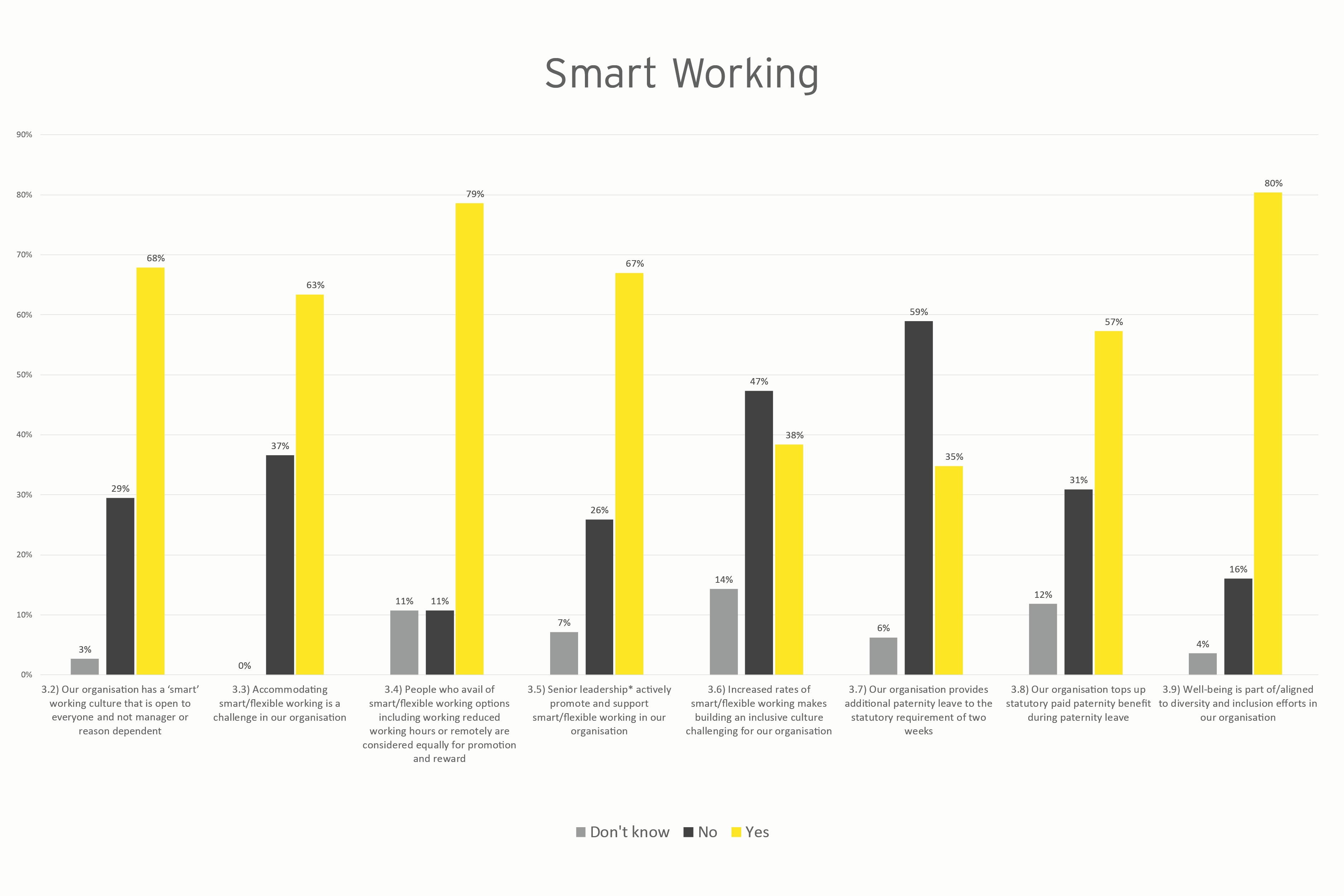
Cultural considerations
At the beginning of this year, almost two-thirds of respondents (63%) said that accommodating flexible working was a challenge for their organisation, notwithstanding the fact that 68% claimed their organisation had a ‘smart’ working culture that is open to everyone and not manager or reason dependent.
The last number of weeks have without doubt illuminated the challenges associated with remote working. We need to learn to do some things differently. When we’re not sitting beside someone in the office, we take for granted the two-minute conversation that happens across the desk or catching people in the corridor. However, overcoming these challenges often simply boils down to being more intentional and considered in our communication. Humans are immensely adaptable, as we’ve learnt over the last month.
A significant minority in the survey (29%) said their organisation did not have a reason- and manager-neutral smart working culture. By this we mean that flexible working conditions are only available to certain people in specific circumstances, e.g. those with a caring responsibility or whose specific manager allows for flexible working, rather than it being available organisation-wide. In many instances ‘flexible working’ became synonymous with something for women or those returning from maternity leave and often automatically stunted career progression. For smart working to work effectively it needs to be afforded to everyone on a ‘reason neutral’ basis, regardless of whether employees have caring responsibilities or not, and it cannot negatively affect promotion and reward.
From many years of working with clients around culture and Diversity & Inclusion, in my experience, smart working lives or dies on three factors – collaboration, trust and leadership.
Ineffective collaboration is the reason that many organisations pull back, particularly from remote working. In my view, the reason for this is the assumption that we take the same tried-and-tested method of running a collaborative session, like a brainstorm for example, and we try to apply the exact same methodology to a virtual environment. The same is true of team management. We do a weekly catch-up with our direct reports and leave them to their own devices for the rest of the week as normal. Sounds logical, right? Wrong.
For remote working to work effectively, it requires an intentional approach that considers the participants’ circumstances and whereabouts, the objective, and the most effective approach of reaching that objective. Nothing earth-shattering there, but the secret lies in the approach, and that “how” isn’t innately obvious to everyone in an organisation where remote working is new. For optimum benefits, organisations should listen to and harness the voice of their own employees in co-creating any new ways of working. Collaborate.
We examined the topic of training in last year’s (2019) survey, finding that that 55% of team leads were trained to support people remotely. Yet, for remote working to succeed, we should ensure all the people managers in our organisations are equipped with the requisite knowledge and skills. Managing both people and projects remotely requires specific training and upskilling for it to be done effectively.
The second factor, and perhaps the elephant in the living room or bedroom or wherever you find your makeshift office, is trust. Many leaders simply do not trust their employees to work remotely. This lack of trust doesn’t automatically reflect on the manager poorly, it could simply be down to that lack of training and experience. Out of sight is out of control, to coin a phrase.
This is as much a challenge for leaders as it is for employees. Managers must learn to adapt to new paradigms and ways of working and to place trust in their team members. However, employees for their part also need to acknowledge that trust works both ways and must be earned. Trust is the super-tanker that will take time to turn as many people learn to completely flip their perspectives of performance from the old to the new – from presenteeism to output.
However, finally and most importantly, the tone at the top will be the reason remote working – and smart working more broadly - thrives or doesn’t in the post-COVID-19 world.
67% of survey respondents said senior leadership actively promote and support smart/flexible working in their organisation. That’s encouraging, but in truth we need more than that as the leadership role really is key.
Leaders set the tone and their own behaviour dictates whether remote and other smart working practices are deemed acceptable or not. They must act as role models in actively demonstrating that these practices are not merely acceptable but are championed and celebrated.
One of the ways we do that in EY is by something we call ‘leave loud’. When senior staff leave early or arrive late due to personal commitments such as sports practice, medical appointments, school runs, or whatever, they don’t slink in and out hoping to evade notice – they do it in a loud, celebratory way that role models behaviour and sets the tone for more junior staff and contributes to a positive culture around flexible working. The same applies to remote working – if senior leaders work remotely, it sets the tone not just for what is acceptable but for what is synonymous with leadership and success.
A stillness in the storm
This crisis has been stormy. But there is also a stillness in the storm that provides an opportunity to reflect on our behaviours and our purpose. To quote author and coach Dave Hollis, ‘in the rush to return to normal, use this time to consider which parts of normal are worth rushing back to.’
Many people will have found a better balance between their working and home lives and will want that continue. We will see an increased emphasis on purpose and long-term value and an expectation that organisations are more involved in addressing global issues and sustainable practices. However, when the current phase of this crisis ends, others will be overjoyed at the prospect of returning to the office; many simply do not have the infrastructure or supports to effectively work from home while others will have too keenly felt the isolation in working on their own.
Right now, we’re remote working in the worst circumstances possible: no childcare, people in a state of anxiety, a national lockdown, rushed technology fixes and not always the right infrastructure at home like private space or a decent chair. People talk about this being the new normal. There is nothing normal about this. But there is, for sure, a new way of working coming, and we need to ask ourselves how we can make the most of the opportunities presented by this unexpected experiment. What can we learn from it that can be applied when the crisis passes? What can it teach us about ourselves and our organisations? Are we going to embrace the benefits of smart working or remain stuck in the past?
Summary
Just before the COVID-19, EY carried out an annual survey on Diversity & Inclusion across the island of Ireland. Smart (or flexible) working is a set of practices that add greater flexibility to work methods through innovative solutions.


